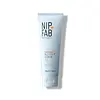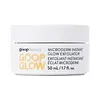What's inside
What's inside
 Key Ingredients
Key Ingredients

 Benefits
Benefits

 Concerns
Concerns

 Ingredients Side-by-side
Ingredients Side-by-side

Water
Skin ConditioningHydrated Silica
AbrasiveCetearyl Alcohol
EmollientCaprylic/Capric Triglyceride
MaskingTriethanolamine
BufferingGlycolic Acid
BufferingGlycerin
HumectantGlyceryl Stearate
EmollientPEG-100 Stearate
Butyrospermum Parkii Butter
Skin ConditioningPrunus Amygdalus Dulcis Oil
Skin ConditioningPhenoxyethanol
PreservativeParfum
MaskingXanthan Gum
EmulsifyingDisodium EDTA
Salicylic Acid
MaskingAloe Barbadensis Leaf Juice
Skin ConditioningDehydroacetic Acid
PreservativeTocopheryl Acetate
AntioxidantCitric Acid
BufferingPotassium Sorbate
PreservativeSodium Benzoate
MaskingSodium Sulfite
PreservativeBenzyl Alcohol
PerfumingLimonene
PerfumingBenzyl Benzoate
AntimicrobialGeraniol
PerfumingButylphenyl Methylpropional
PerfumingCI 42090
Cosmetic ColorantWater, Hydrated Silica, Cetearyl Alcohol, Caprylic/Capric Triglyceride, Triethanolamine, Glycolic Acid, Glycerin, Glyceryl Stearate, PEG-100 Stearate, Butyrospermum Parkii Butter, Prunus Amygdalus Dulcis Oil, Phenoxyethanol, Parfum, Xanthan Gum, Disodium EDTA, Salicylic Acid, Aloe Barbadensis Leaf Juice, Dehydroacetic Acid, Tocopheryl Acetate, Citric Acid, Potassium Sorbate, Sodium Benzoate, Sodium Sulfite, Benzyl Alcohol, Limonene, Benzyl Benzoate, Geraniol, Butylphenyl Methylpropional, CI 42090
Water
Skin ConditioningAlumina
AbrasiveGlycerin
HumectantCetearyl Alcohol
EmollientGlycolic Acid
BufferingHydrated Silica
AbrasiveLimnanthes Alba Seed Oil
Skin ConditioningSqualane
EmollientGlyceryl Stearate
EmollientCetearyl Olivate
Sodium Hydroxide
BufferingSorbitan Olivate
EmulsifyingGarnet Powder
AbrasiveQuartz
AbrasiveAscorbic Acid
AntioxidantTerminalia Ferdinandiana Fruit Extract
AntioxidantZiziphus Jujuba Seed Extract
Skin ConditioningTerminalia Ferdinandiana Seed Oil
AntioxidantOlea Europaea Leaf Extract
PerfumingCarthamus Tinctorius Seed Oil
MaskingCitrus Aurantifolia Oil
CleansingCitrus Aurantium Dulcis Peel Oil
MaskingCitrus Limon Peel Oil
MaskingCitrus Nobilis Oil
MaskingLavandula Hybrida Oil
EmollientVetiveria Zizanoides Root Oil
MaskingButyrospermum Parkii Butter
Skin ConditioningGlyceryl Caprylate
EmollientSodium Stearoyl Glutamate
CleansingCitric Acid
BufferingPhenethyl Alcohol
MaskingXylitol
HumectantCaprylic Acid
CleansingCaprylhydroxamic Acid
Galactoarabinan
Decyl Glucoside
CleansingLevan
Skin ProtectingDehydroxanthan Gum
Emulsion StabilisingCaprylyl Glycol
EmollientCitral
PerfumingLimonene
PerfumingWater, Alumina, Glycerin, Cetearyl Alcohol, Glycolic Acid, Hydrated Silica, Limnanthes Alba Seed Oil, Squalane, Glyceryl Stearate, Cetearyl Olivate, Sodium Hydroxide, Sorbitan Olivate, Garnet Powder, Quartz, Ascorbic Acid, Terminalia Ferdinandiana Fruit Extract, Ziziphus Jujuba Seed Extract, Terminalia Ferdinandiana Seed Oil, Olea Europaea Leaf Extract, Carthamus Tinctorius Seed Oil, Citrus Aurantifolia Oil, Citrus Aurantium Dulcis Peel Oil, Citrus Limon Peel Oil, Citrus Nobilis Oil, Lavandula Hybrida Oil, Vetiveria Zizanoides Root Oil, Butyrospermum Parkii Butter, Glyceryl Caprylate, Sodium Stearoyl Glutamate, Citric Acid, Phenethyl Alcohol, Xylitol, Caprylic Acid, Caprylhydroxamic Acid, Galactoarabinan, Decyl Glucoside, Levan, Dehydroxanthan Gum, Caprylyl Glycol, Citral, Limonene
Ingredients Explained
These ingredients are found in both products.
Ingredients higher up in an ingredient list are typically present in a larger amount.
This ingredient is also known as shea butter. It is an effective skin hydrator and emollient.
Emollients help soothe and soften your skin. It does this by creating a protective film on your skin. This barrier helps trap moisture and keeps your skin hydrated. Emollients may be effective at treating dry or itchy skin.
Shea butter is rich in antioxidants. Antioxidants help fight free-radicals, or molecules that may harm the body. It is also full of fatty acids including stearic acid and linoleic acid. These acids help replenish the skin and keep skin moisturized.
While Shea Butter has an SPF rating of about 3-4, it is not a sunscreen replacement.
Shea butter may not be fungal acne safe. We recommend speaking with a professional if you have any concerns.
Learn more about Butyrospermum Parkii ButterCetearyl alcohol is a mixture of two fatty alcohols: cetyl alcohol and stearyl alcohol. It is mainly used as an emulsifier. Emulsifiers help prevent the separation of oils and products. Due to its composition, it can also be used to thicken a product or help create foam.
Cetearyl alcohol is an emollient. Emollients help soothe and hydrate the skin by trapping moisture.
Studies show Cetearyl alcohol is non-toxic and non-irritating. The FDA allows products labeled "alcohol-free" to have fatty alcohols.
This ingredient is usually derived from plant oils such as palm, vegetable, or coconut oils. There is debate on whether this ingredient will cause acne.
Due to the fatty acid base, this ingredient may not be Malassezia folliculitis safe.
Learn more about Cetearyl AlcoholCitric Acid is an alpha hydroxy acid (AHA) naturally found in citrus fruits like oranges, lemons, and limes.
Like other AHAs, citric acid can exfoliate skin by breaking down the bonds that hold dead skin cells together. This helps reveal smoother and brighter skin underneath.
However, this exfoliating effect only happens at high concentrations (20%) which can be hard to find in cosmetic products.
Due to this, citric acid is usually included in small amounts as a pH adjuster. This helps keep products slightly more acidic and compatible with skin's natural pH.
In skincare formulas, citric acid can:
While it can provide some skin benefits, research shows lactic acid and glycolic acid are generally more effective and less irritating exfoliants.
Most citric acid used in skincare today is made by fermenting sugars (usually from molasses). This synthetic version is identical to the natural citrus form but easier to stabilize and use in formulations.
Read more about some other popular AHA's here:
Learn more about Citric AcidGlycerin is already naturally found in your skin. It helps moisturize and protect your skin.
A study from 2016 found glycerin to be more effective as a humectant than AHAs and hyaluronic acid.
As a humectant, it helps the skin stay hydrated by pulling moisture to your skin. The low molecular weight of glycerin allows it to pull moisture into the deeper layers of your skin.
Hydrated skin improves your skin barrier; Your skin barrier helps protect against irritants and bacteria.
Glycerin has also been found to have antimicrobial and antiviral properties. Due to these properties, glycerin is often used in wound and burn treatments.
In cosmetics, glycerin is usually derived from plants such as soybean or palm. However, it can also be sourced from animals, such as tallow or animal fat.
This ingredient is organic, colorless, odorless, and non-toxic.
Glycerin is the name for this ingredient in American English. British English uses Glycerol/Glycerine.
Learn more about GlycerinGlyceryl Stearate is a mix of glycerin and stearic acid.
It is used to stabilize the mixing of water and oil ingredients. By preventing these ingredients from separating, it can help elongate shelf life. It can also help thicken the product's texture.
As an emollient, it helps soften skin and supports barrier-replenishing ingredients.
In cosmetics, Glyceryl Stearate is often made from vegetable oils or synthetically produced.
This ingredient may not be fungal-acne safe
Fun fact: The human body also creates Glyceryl Stearate naturally.
Learn more about Glyceryl StearateGlycolic Acid is arguably the most famous alpha hydroxy acid (AHA) with tons of research backing its benefits.
It is found naturally in sugar cane but the form used in skincare is usually synthetic for purity and stability.
Glycolic acid removes the top layer of dead skin cells to allow newer and fresher ones to emerge.
AHAs work by breaking down the structural “glue” that holds old skin cells in place. When that buildup is gone, your skin can renew itself more efficiently.
Research also shows glycolic acid stimulates collagen production, helping to firm and thicken the skin over time. This is one of its biggest advantages over other AHAs.
Overall, glycolic acid helps with:
Fun fact: Glycolic acid boosts skin hydration by helping it produce molecules that increase hyaluronic acid naturally.
To work best, glycolic acid products should have a pH between 3-4 (that’s where exfoliation is most effective but still gentle on skin).
The pH and concentration of a product are key to its effectiveness:
It is normal to feel a slight stinging sensation when using glycolic acid. This usually fades as your skin adjusts.
Because glycolic acid has the smallest molecular size in the AHA family, it can penetrate deeper, which enhances its effectiveness but also makes it more likely to irritate sensitive skin.
If your skin is very sensitive or prone to rosacea, glycolic acid may be too strong; in that case, try milder options like lactic acid or a PHA instead.
Recent studies suggest glycolic acid might even help protect against UV damage. But don’t skip sunscreen! Freshly exfoliated skin is more sensitive to the sun.
Glycolic acid is a skincare superstar. It smooths, brightens, hydrates, and firms the skin. Unless you’re highly sensitive, it’s well worth adding to your routine.
Read more about some other popular AHA's here:
Learn more about Glycolic AcidHydrated Silica is a type of silicon dioxide. It is called 'hydrated silica' because it is silica with extra bonded water atoms.
It is an absorbent and abrasive, meaning it is exfoliating.
Silica is often used for absorption and can help reduce shine when products are applied.
Learn more about Hydrated SilicaLimonene is a fragrance that adds scent and taste to a formulation.
It's found in the peel oil of citrus fruits and other plants such as lavender and eucalyptus. The scent of limonene is generally described as "sweet citrus".
Limonene acts as an antioxidant, meaning it helps neutralize free radicals.
When exposed to air, oxidized limonene may sensitize the skin. Because of this, limonene is often avoided by people with sensitive skin.
The term 'fragrance' is not regulated in many countries. In many cases, it is up to the brand to define this term. For instance, many brands choose to label themselves as "fragrance-free" because they are not using synthetic fragrances. However, their products may still contain ingredients such as essential oils that are considered a fragrance.
Learn more about LimoneneWater. It's the most common cosmetic ingredient of all. You'll usually see it at the top of ingredient lists, meaning that it makes up the largest part of the product.
So why is it so popular? Water most often acts as a solvent - this means that it helps dissolve other ingredients into the formulation.
You'll also recognize water as that liquid we all need to stay alive. If you see this, drink a glass of water. Stay hydrated!
Learn more about Water